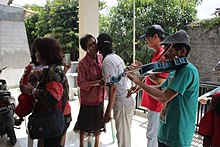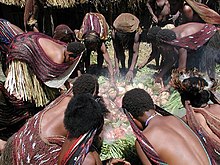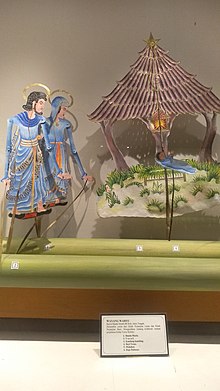
Christmas in Indonesia, locally known as Natal from the Portuguese word for Christmas, is celebrated with various traditions throughout the country.
Despite the majority of Indonesians being Muslims, Christmas is still widely celebrated in Indonesia. Many Indonesians who are not Christian celebrate Christmas as a secular holiday.
Overview
Indonesia has approximately 28 million Christians, of which about 70% are Protestant and 30% are Roman Catholics.
In regions with a Christian majority, both Protestants and Catholics celebrate Christmas with ceremonies and local food. In big cities, shopping centers are decorated with plastic Christmas trees and Santa Claus figures (locally known as Sinterklas, derived from the Dutch word Sinterklaas). Many local television channels broadcast Christmas musical concerts, and the government organizes the annual national Christmas celebration. In addition to traditional foods, there are also unique Christmas Day foods, such as traditional desserts like nastar (pineapple tart) and kastengel (from Dutch word kaasstengel), or 'putri salju'.
By region
Jakarta

In North Jakarta, Indonesians of Portuguese descent live mainly in Kampung Tugu. After Christmas Mass, Christians in Kampung Tugu will visit the cemetery next to their local church and start the rabo-rabo tradition.
The rabo-rabo tradition consists of playing Kroncong music and dancing together around the village area. Locals will sing and visit each other's relatives. Relatives who are visited must later join the game until a chain of players forms on the streets. The visits will continue until they arrive at the last house in the area.
Papua

In the Papua region, after Christmas Mass, a ritual cooking of pork for feasting is held using a Barapen (grilling stone). The pork meat is cooked in between hot stones that are heated using wood. Instead of using matches, Papuan people scrape the wood continuously to produce heat to set it on fire. In order to prepare the Barapen, Papuan men dig a hole to put the hot stones in. At the same time, Papuan women prepare vegetables such as sweet potato, water spinach, fern, cassava, spinach, and papaya. Hot stones are stacked on the base of the hole and the pork and vegetables are put into the hole and covered with another layer of hot stones. The pork is cooked in the hole for half a day. The tradition of Barapen is an expression of gratitude, togetherness, sharing, and love, characterised by eating pork together.
Ambon
In Negeri Naku, South Leitimur, Ambon, there is a ceremony called cuci negeri (cleaning the nation). This ceremony symbolises the purification and liberation of sins from the local people and their environment. The cuci negeri starts with a gathering in the community function hall for each clan to hold their own traditional ritual. From there, the Ambonese walk to the traditional function hall. They sing and dance to the sounds of the tifa (traditional music instrument). Along the way, the women bring some offerings like betel, areca nut, and traditional drink called sopi. During Christmas eve celebrations in the Maluku, church bells will ring and ships will sound their sirens.
Yogyakarta

In the Yogyakarta area, Christmas celebrations are marked by a wayang kulit adaptation of the Nativity scene. Church Mass is led by the priest who wears traditional Javanese attire (wearing beskap and blankon) and speaks in the local language. Similar to Eid al-Fitr (lebaran) and Chinese New Year (imlek), during Christmas time, people visit friends and family; children may receive money in an envelope from elders.
Manado
The pre-Christmas celebrations in Manado start from 1 December when the regional government officers go on the "Christmas Safari" and observe the Mass in a different district every day. As part of tradition, some residents of Manado join a carnival or visit and clean their families' graves. The series of Christmas celebrations will finish in the first week of January with a festival called kunci taon. During this festival, there is a carnival across the region featuring unique costumes.
Bali
Most Christian villages in Bali are located on the southern side of the island. In those villages, road decorations called penjor (made from yellow coconut leaves) are made for Christmas, which symbolise the Anantaboga dragon. The Christmas celebration draws influence from Balinese Hinduism.
In Bali, the Christmas tree is made from chicken feathers. This unique tree has been imported to some European countries.
Toraja
Torajan people celebrate Christmas by having a cultural festival called Lovely December. This festival consists of dancing, a culinary celebration, cultural carnival, bamboo music performance and handicraft exhibition. The festival is ended by fireworks and Lettoan procession which is held on 26 December. Lettoan is a ritual of having pig parade with cultural symbols that represent three dimensions of human life. Those three symbols are:
- Saritatolamban, shaped like stairs, which represents a prayer and hope for a better life (as the steps which always go up).
- The Sun, which represents the source of life and light.
- Tabang flower, which represents success in the Torajan people's life.
North Sumatra

For the Batak in North Sumatra, Christmas Day is always followed by sacrificing an animal. The local people will save money for months beforehand and buy this animal together. This tradition is called marbinda and shows togetherness and mutual cooperation. The sacrificed animal can be a pig, a buffalo, or an ox, and the meat will be shared to all the people that participate in the purchasing of the animal.
National Christmas Celebration
Every year, the Ministry of Religious Affairs holds the National Christmas Celebration of the Republic of Indonesia. The program started in 1993 after a suggestion from Tiopan Bernhard Silalahi, who was Minister of Administrative and Bureaucratic Reform in the Sixth Development Cabinet, who has Protestant background, to the then President of Indonesia Suharto. Since that time, the National Christmas Celebration has been held almost every year (and was held as a virtual event due to the COVID-19 pandemic in 2020-21). Exceptions were in 2004, which was canceled as a condolence for the victims of the 2004 Indian Ocean earthquake and tsunami, in 2018, which was canceled as a condolence for the victims of the 2018 Sunda Strait tsunami, and in 2022, which was also planned to be cancelled before being delayed at the last minute as a condolence for the victims of the 2022 West Java earthquake.
Until 2013, National Christmas Celebration was held in Jakarta and the most common used venue was Jakarta Convention Center. Since 2014, the tradition was changed by the then newly-elected President of Indonesia Joko Widodo. This is the list of National Christmas Celebration hosts since 2014:
| Year | Host | Province | Date | Remarks |
|---|---|---|---|---|
| 2014 | Jayapura City | Papua | 27 December 2014 | For the first time National Christmas Celebration was held outside Jakarta Special Capital Region |
| 2015 | Kupang City | East Nusa Tenggara | 28 December 2015 | |
| 2016 | Minahasa Regency | North Sulawesi | 27 December 2016 | For the first time National Christmas Celebration was held in a regency |
| 2017 | Pontianak City | West Kalimantan | 28 December 2017 | For the first time outside the capital of Indonesia, National Christmas Celebration will be held in a province and a city whose majority of population are not Christians |
| 2019 | Bogor | West Java | 27 December 2019 | |
| 2023 | Surabaya | East Java | 27 December 2023 |
See also
References
- https://www.expatindo.org/celebrating-christmas-indonesia/
- https://www.twinkl.com.au/blog/how-do-indonesians-celebrate-christmas
- (in Indonesian) Sensus Penduduk 2010:Penduduk Indonesia Menurut Wilayah dan Agama yang Dianut, Badan Pusat Statistik. Accessed by 15 December 2014.
- Christmas celebration, the Indonesian way, ID Nugroho & Anissa S. Febrina, The Jakarta Post, Jakarta. 30 December 2009. Diakses pada 15 December 2014.
- Christmas in Indonesia, whychristmas.com. Diakses pada 15 December 2014.
- "10 Tradisi Perayaan Natal Di Indonesia." Misplaced Pages, Wikimedia Foundation, 18 Dec. 2022, travel.kompas.com/read/2022/12/18/200800227/10-tradisi-perayaan-natal-di-indonesia-bernyanyi-keliling-kampung?page=all.
- "Jakarta Christians Uphold Portuguese Christmas Tradition." Misplaced Pages, Wikimedia Foundation, 21 Dec. 2016, www.ucanews.com/news/jakarta-christians-uphold-portuguese-christmas-tradition/77942.
- Sukacita Natal di Nabire Archived 16 December 2014 at the Wayback Machine, HidupKatolik.com – 23 December 2012. Accessed by 15 December 2014.
- ^ Unique Indonesian Traditions for Celebrating Christmas, Tempo.co – Rina Atmasari. 25 December 2013. Diakses pada 15 December 2014.
- (in Indonesian) Warga Negeri Naku Gelar Adat Cuci Negeri Archived 16 December 2014 at the Wayback Machine, AntaraNews.com. Diakses pada 16 December 2014.
- ^ (in Indonesian) Tradisi Natal di Indonesia Archived 20 April 2015 at the Wayback Machine, Muna Zakiah: KebudayaanIndonesia.net – 20 December 2013. Diakses pada 16 December 2014.
- Balinese Christians: In Search of Tradition, Benito Lopulalan in Bali Today: Modernity by Jean Couteau et al. Page 111-115. 2005. Jakarta: KPG (Kepustakaan Populer Gramedia). Diakses pada 16 December 2014.
- (in Indonesian) Uniknya Pohon Natal dari Bulu Ayam Archived 15 December 2014 at the Wayback Machine, Ely – Ciputra Entrepreneurship. 19 December 2011. Diakses pada 15 December 2014.
- Tana Toraja Festival held on Dec. 25 to boost tourism Archived 16 December 2014 at the Wayback Machine, The Jakarta Post. 22 December 2011. Diakses pada 16 December 2014.
- (in Indonesian) "Lettoan" Meriahkan "Lovely December" Toraja, Aditia Maruli. AntaraNews.com – 27 December 2009. Diakses pada 16 December 2014.
- (in Indonesian) Rayakan Natal, Masyarakat Batak Juga Sembelih Hewan Archived 16 December 2014 at the Wayback Machine, TourismNews.co.id Diakses pada 16 December 2014.
- ^ (in Indonesian) Sejarah Perayaan Natal Nasional Republik Indonesia on YouTube Diakses pada 5 December 2017.
- (in Indonesian) Umat Kristen Prihatin, Perayaan Natal Nasional Dibatalkan. 29 December 2004. Diakses pada 5 December 2017.
- (in Indonesian) Joko Widodo Ungkap Alasan Perayaan Natal Nasional Digelar di Papua. 27 December 2014. Diakses pada 5 December 2017.
- (in Indonesian) Pidato Presiden Joko Widodo Pada Perayaan Natal Bersama Nasional 2014, di Stadion Mandala, Jayapura, Papua, 27 Desember 2014
- (in Indonesian) Ribuan Umat Kristiani Hadiri Perayaan Natal Nasional di Kupang
- (in Indonesian)Warga Minahasa Antusias Hadiri Natal Nasional 2016
- (in Indonesian) Perayaan Natal Nasional 2017 Dipusatkan di Pontianak dan Dihadiri Presiden Joko Widodo
- (in Indonesian)Joko Widodo talks with Christians while attending the 2019 National Christmas Celebration which was held at the Sentul International Convention Center (SICC)
External links
 Media related to Christmas in Indonesia at Wikimedia Commons
Media related to Christmas in Indonesia at Wikimedia Commons